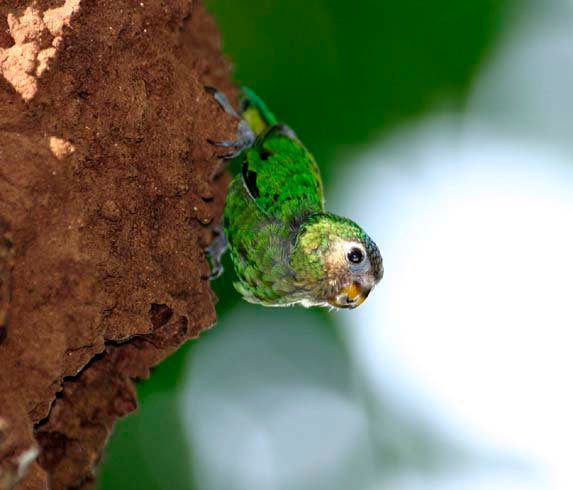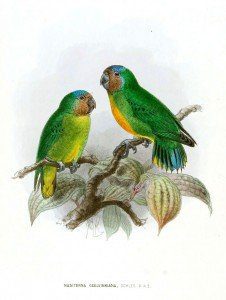Content
|
|---|
Description
The Geelvink Pygmy-Parrot (Micropsitta geelvinkiana) has 9 cm.. length between 13 and 17 g. of weight.
The coverts headphones are of color brown with fusion to blue-green in the part rear; crown purple-blue; Upperparts green, Middle coverts with centers of color blackish. The flight feather Black with narrow green borders in vane outer. The underparts Green Center of chest and belly ocher-yellow, more warm towards the part superior of the chest. Uppertail Yellow. Central feathers of the tail blue, Green Tips with yellow spots and black exterior.
The bill grey; irises of color red or brown orange; legs grey.
Female with less blue of the crown and underparts greenish yellow.
Immature with the bill mostly yellow in color and gray tipped.
- Sound of the Geelvink Pygmy-Parrot.
Subspecies description
-
: (Schlegel, 1871) – The nominal
Micropsitta geelvinkiana geelvinkiana
-
: (Salvadori, 1876) – The male has the head Brown marks on the belly yellow and orange. Female with the crown blue and underparts greenish.
Micropsitta geelvinkiana misoriensis
Habitat:
With distributes in lowland, secondary growth, cultivated areas with isolated trees, and around native gardens, until 300 meters or higher altitudes. The birds are found in groups of 4-5. and is them has seen associate it with other birds in them trees low of berries that accrued in the forest. very shy.
Reproduction:
They dig caves in termite tree in which to lay their eggs (also used for rest cavities at night), often close to the ground. The nesting It was observed from mid-June to August. Arndt He found two young in a nest which were visited by the female every two hours. The chamber was filled with dust from the termite mound and contained some broken egg shell and feathers.
Food:
Probably Lichen and fungi from the bark of the trees. As in other Meeki, crushed seeds were found in the stomach of a bird collected.
Distribution:
Size distribution (reproduction / resident): 2,500 km2
Are observed only in Numfor and Biak island, (Indonesian), up to about 300 meters above sea level. In 1991 It was thought that the global population was around of 10.000 and stable, but in 1997 searches for the species over a period of 12 days suggested that it was either rare or easily missed, with observations of a single day, sometimes only with sound contacts.
Subspecies distribution:
-
: (Schlegel, 1871) – Nominal
Micropsitta geelvinkiana geelvinkiana
-
: (Salvadori, 1876) – Present in Biak island.
Micropsitta geelvinkiana misoriensis
Conservation:
• Current IUCN Red List category: Near threatened
• Population trend: Decreasing
The size of the world population It has not been quantified; in 1991 It was estimated in approximately 10,000 specimens. The species is described as well distributed in good numbers in lowland primary and secondary forests. (pit et to the. 1997).
There are no data on population trends, but the species is suspected that it is decreasing at a rate of slow to moderate, due to loss of habitat.
"Geelvink Pygmy-Parrot" in captivity:
Not found in poultry farming.
Alternative names:
– Geelvink Pygmy-Parrot, Geelvink Bay Pygmy Parrot, Geelvink Pygmy Parrot (ingles).
– Micropsitte de Geelvink (French).
– Geelvinkspechtpapagei, Geelvink-Spechtpapagei (German).
– Micropsitta geelvinkiana (Portuguese).
– Microloro de Geelvink (español).
scientific classification:
– Order: Psittaciformes
– Family: Psittaculidae
– Scientific name: Micropsitta geelvinkiana
– Genus: Meeki
– Citation: (Schlegel, 1871)
– Protonimo: Nasiterna pygmaea Geelvinkiana
Images "Geelvink Pygmy-Parrot"
Videos "Geelvink Pygmy-Parrot"
————————————————————————————————
“Geelvink Pygmy-Parrot” (Micropsitta geelvinkiana)
Sources:
– Avibase
– Parrots of the World – Forshaw Joseph M
– Parrots A Guide to the Parrots of the World – Tony Juniper & Mike Parr
– Birdlife
– Photos:
(1) – A juvenile bird on the termite mount (nest). by mehdhalaouate – lynx
(2) – “Nasiternageelvinkianakeulemans” by John Gerrard Keulemans – Ornithological Miscellany. Volume 1. Licensed under Public Domain via Wikimedia Commons.
– Sounds: George Wagner (Xeno-canto)



